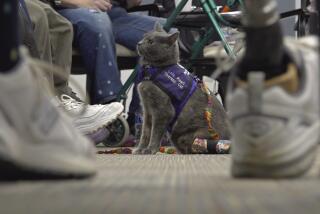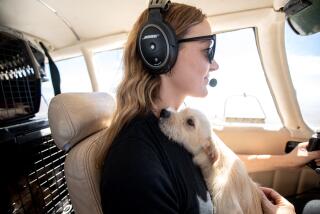Therapy dogs make the rounds in more healthcare settings
- Share via
“Pets are embedded in the soul of our humanity,” says Dr. Edward Creagan, an oncologist at the Mayo Clinic in Rochester, Minn., as he describes the special fondness and respect he has for a certain other member of the clinic’s staff.
That would be Dr. Jack, a 10-year-old miniature pinscher who sees about eight to 10 patients a day — sometimes he goes for a walk with them, sometimes he gives them five and sometimes he just curls up next to them so they can catch some z’s together.
Dr. Jack is a therapy dog, just one class in the corps of canine healthcare “professionals” known as assistance dogs. And, like service dogs (which assist individuals with disabilities), therapy dogs are put to work more and more these days.
Trained to visit hospitals, hospices, rehab centers and nursing homes, they trot from room to room, spending five minutes here, 25 minutes there, letting youngsters kiss them and oldsters comb them — unflappable four-footed friends to everyone they meet. Across the country, more than 10,000 trained person-plus-pet teams are registered in Pet Partners, a program established in 1990 by the Delta Society, a nonprofit organization that believes positive interactions with animals can improve people’s health and well-being.
Jack is the only dog based at the Mayo Clinic, but he has multitudinous peers making their rounds in healthcare facilities across the country, including more than 50 in UCLA’s People-Animal Connection. The dogs — teamed with their human counterparts — make 500 to 600 visits a month to patients in more than 40 units of UCLA’s medical facilities, says the program’s director, Jack Barron.
In a less than shocking development, Barron believes golden retrievers and Labradors are probably the breeds best suited to the life of a therapy dog: “They were brought into this world to please people.” That said, he describes his crew as “a smorgasbord of wonderful dogs” — from four Great Pyrenees, about 100 pounds each, to a 2.5-pound long-haired Chihuahua.
Therapy dogs function in two ways. Sometimes they work with a healthcare provider and take an active part in patient treatment — like Silvija, a 5-year-old mix of golden retriever and Labrador that works with Amy Johnson, a speech-language pathologist in South Pasadena. Silvija’s job is to motivate, reward and interact with patients, Johnson says. For example, “for one little girl, getting a simple word out is a big deal. But she has to vocalize if she wants to get Silvija to go through my plastic tunnel.”
Other times therapy dogs and their human partners simply engage in so-called animal-assisted activities — for example, they drop by a patient’s room just to say hello (the human) and lie on the patient’s bed for a while (the dog).”We all benefit from being with our own animals,” says Bill Kueser, vice president of marketing for the Delta Society. “And we share this benefit when we share our animals with people who can’t have them themselves.”
To join the People-Animal Connection, volunteers have to take a people-only workshop and then be evaluated with their dogs on 24 exercises. “You either pass or you don’t,” Barron says. The activities may sound simple enough, but not every dog-human combo is cut out for them. “People tell me, ‘My dog would be perfect,’” Barron says. “So I ask, ‘How many times have you been in an intensive care pediatric unit? How will your dog react? How will you react?’”
Therapy dogs must ignore loud noises, strange smells and other dogs they might run into. They can’t bother any people who don’t want to be bothered. They must also be friendly and comfortable socializing with strangers. Their human partners must be able to do all of the above too. “A dog picks up on any nervousness in a person,” Barron says. “It comes down through the leash.”
Research has shown that therapy dogs can have measurable health benefits in patients. In a 2007 study, 76 adults with advanced heart failure received either a 12-minute visit from a volunteer with a therapy dog, a 12-minute visit from a volunteer only or 12 minutes of their usual care.
Compared with the usual-care group, the canine group had significantly greater decreases in blood pressure during and after the visit. Compared with the volunteer-only group, they had significantly greater decreases in levels of stress hormones epinephrine and norepinephrine during and after the visit. And compared with either group, they had significantly greater drops in a measure of “total anxiety.”
In another study presented at a meeting earlier this year, 28 patients interacted with a therapy dog for 15 minutes about half an hour before they had an MRI. Six other patients had no intervention before their MRI. The results showed that an interaction with a therapy dog could be used in place of drug therapy to reduce patient anxiety.
Therapy dogs have also been shown to reduce loneliness and depression and to stimulate conversation among nursing home residents.
After more than a decade of working with the People-Animal Connection, Barron is convinced that therapy dogs are effective. “We’ve had so many outcomes,” he says, “all good.” He tells the story of a patient in extreme pain in the emergency room who received a visit from a therapy golden retriever named Jackson. The patient’s doctor told Jackson’s handler, “I can’t believe how calm you got him. This dog did more for my patient than morphine.”
And he tells of a standard poodle named Apollo visiting an 11-year-old girl who’d been in a coma for some time. About half an hour after he left, the girl sat up and started asking, “Where’s Apollo? Where’s Apollo?”
“Some people could say that just happened,” Barron says. “But I say, How do you know it didn’t happen because the dog was on her bed?”
More to Read
Sign up for Essential California
The most important California stories and recommendations in your inbox every morning.
You may occasionally receive promotional content from the Los Angeles Times.























